In my early film photography years (about a decade ago) I tried a few cheap medium format cameras (I own both a Moskva and a Lubitel, as well as a couple of old Kodak folders) but nothing stuck. Too fiddly, not reliable enough, etc. Obviously that had nothing to do with medium format and everything to do with the choice of cameras I tried it on (and my skill at making something of them).
A decade later, I have a lot more experience with film and with rangefinders, and in the spring I decided to revisit the issue. To be honest, it wasn’t a fully informed and rational process but rather reading and finding out about the Fuji GW690iii, a rather underlooked and underloved camera, which has the welcome side-effect of making it rather more affordable than the more renowned Hasselblads, Mamiyas and Bronicas.
After a few weeks of weighing matters, I decided to go for it when the Ricoh GR1 that I’d put up for sale at a local camera store found a new owner. I paid around 500 USD for the Fuji GW690iii in perfect working condition, and factoring in the sale of the Ricoh it only really cost me about 200. I’ve owned it now for around 6 months, enough, I feel, to have a relatively informed opinion about what’s good and what’s problematic with this camera. Spoiler alert, I definitely weigh on the side of good.
A bit of history
The Fuji GW690iii was the last in a relatively long line of Fuji cameras that have one thing in common: the size of their negatives, 6x9cm, which I’m told is as large as medium format gets (if you exclude the 6×12 and 6×17 panoramic cameras that are way wider).
The ancestor of the Fuji GW690iii is the Fujica G690, released in 1968 which had interchangeable lenses. Noting that few of the lenses sold apart from the 65mm (wide) and the 100mm (standard), in 1978 Fuji released the Fujica GW690 Professional with a fixed 90mm f/3.5 lens. In 1980 a wide version (GSW690) was released with a fixed 65mm f/5.6 lens. The two designs would stay mostly the same with some minor improvements in successive iterations and some variant 6×7 and 6×8 models until the Fuji GW690iii was released in 1992.
A basic description
The Fuji GW690iii is a fairly bulky camera weighing 1510g. It has been dubbed the Texas Leica since it’s a big and large rangefinder.
The lens is an EBC Fujinon 90mm, f/3.5 with five elements in five groups and a No. 0 interlens shutter. It has 5 straight shutter blades. It focuses at one meter minimal distance and takes 67mm filters. The focal length is equivalent to around 40-45mm in 135 terms (I haven’t been able to find the exact number).
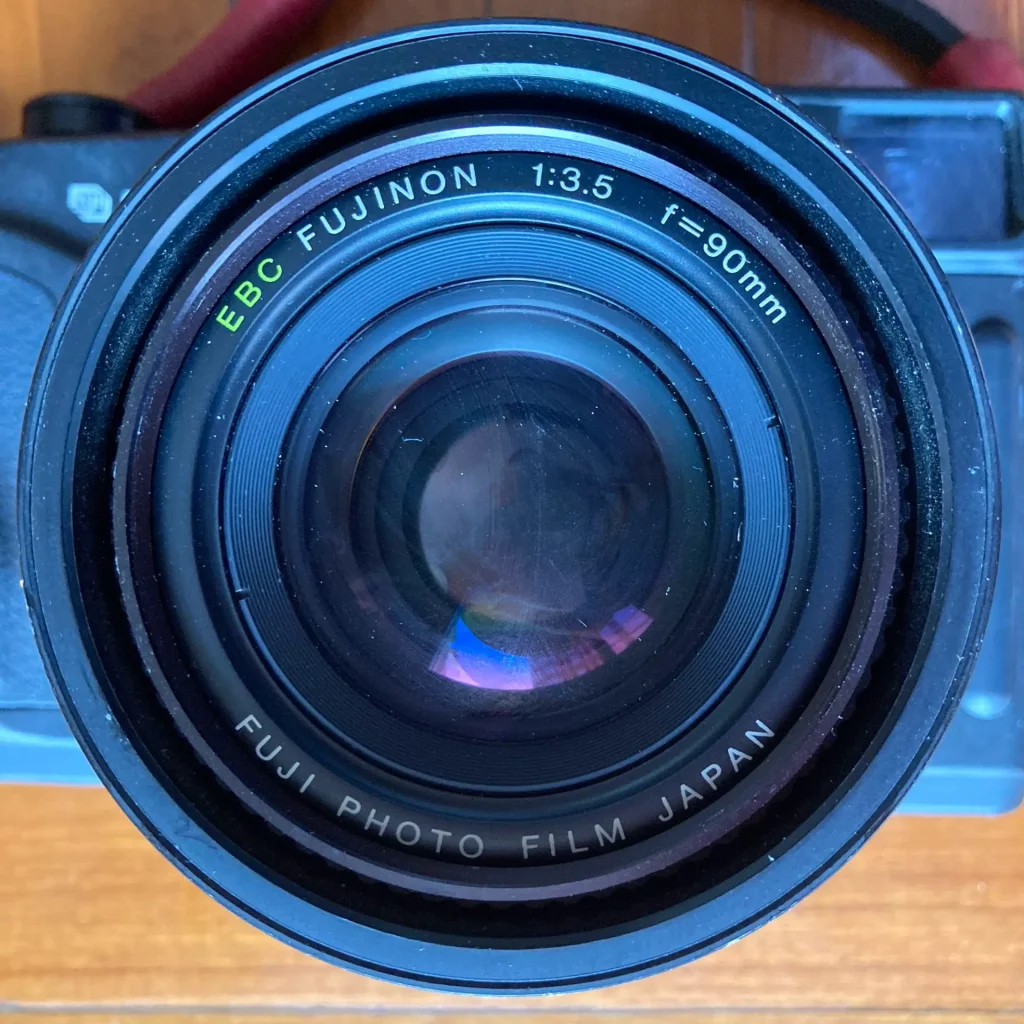
In terms of features, the Fuji GW690iii is about as minimalistic as it gets: it’s a rangefinder, and does not feature a meter. It operates without a battery. In other words, full manual. You do get a hotshoe though, which is nice.
It offers apertures of f/3.5 to f/32 and speeds to 1/500s to 1s. For longer exposures, it features a T mode, more on this below.
The camera takes 220 and 120 film, which means in this day and age that for all intents and purposes it takes 120 film. You get 8 6×9 shots on a roll.
One unusual piece of design is that the aperture and speed settings are set on the lens itself, in two parallel rings hidden by the retractable lens hood.
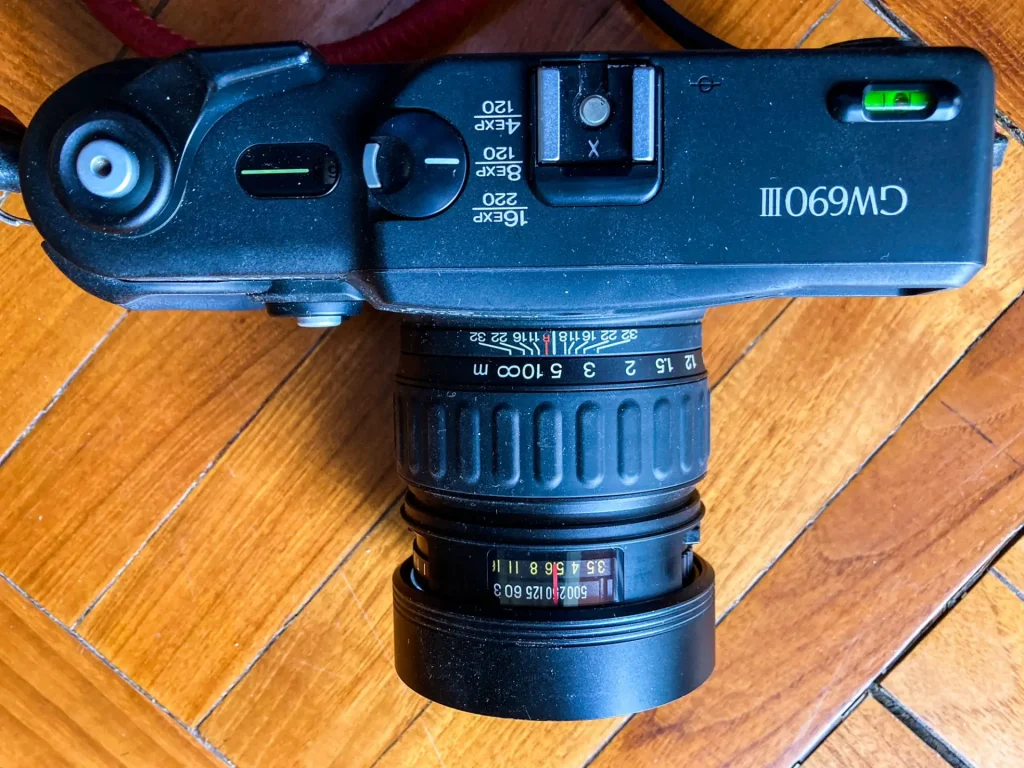
The top and back of the Fuji GW690iii has no dials except the film selection (220 16 exposures, 120 8 exposures or 120 4 exposures).
Finally, the camera has an exposure counter at the bottom. The spring from the counter explains the super loud click you get when you press the shutter.
Fuji GW690iii – The good
As you’d expect, the massive negatives is probably the most striking positive feature of the Fuji GW690iii. I said it previously, I have limited experience with medium format, but for the first time in my life when I got the scans of the first rolls I shot with the GW690iii back, I *got* it. There is a specific look to these shots that I’ve not had with any other camera.
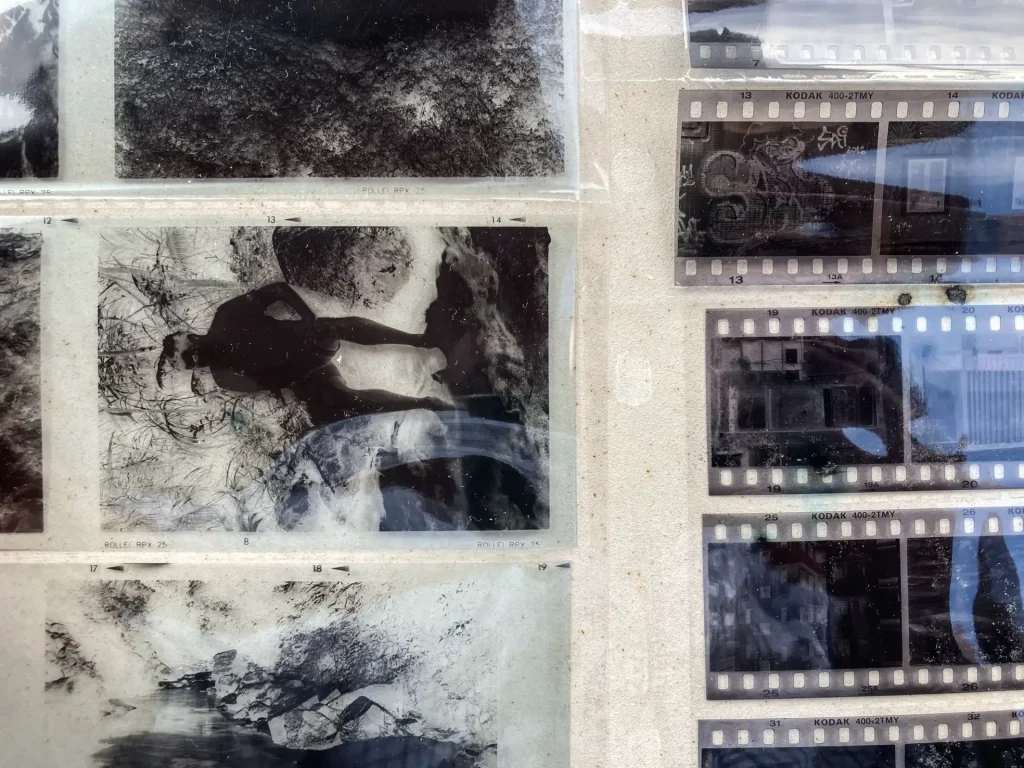
When shooting wide open, while you won’t get super wild bokeh, f/3.5 is more than enough to deliver a really cool background blur, which is great for portraits and street. Of course, at the opposite end of the aperture spectrum, my usual street photography default of shooting at f/8 or f/11 becomes somewhat problematic because that’s still pretty shallow, but for the most part that’s nothing to do with the camera, it’s a medium format thing.
Focusing the Fuji GW690iii is super easy, and the focus patch while unusually round (on my XPAN it’s square) is relatively visible in most conditions. As usual (again) when shooting vertical you need to be careful not to block the light in the focus patch by putting your hand below the lens to focus (the natural way to do it) but this isn’t specific to this camera.
While the Fuji GW690iii is undeniably bulky and heavy, it’s also well designed so that when I’m shooting with it I don’t particularly feel it’s weight. I used to own a Canon 7D, and with a decent 50mm lens, it didn’t weigh much less than the GW690iii. My other main film camera, the xpan, is slightly lighter with a lens attached, but because of its form factor it actually feels bulkier. All this to say that I didn’t find the GW690iii to be particularly cumbersome for a medium format camera. The fact that its body is designed as an SLRs also feels “natural” both with handling and with viewing/shooting.
I’ve said above how large the negatives are, but I should stress how sharp the lens is as well. A well focused shot really delivers in terms of drawing you in. Blurred backgrounds when they occur are smooth and pleasant although I’ve not tried deliberate bokeh style photos (like portraits with foliage backgrounds, etc.)
One last thing in the good side (but maybe to be tested further): the Fuji GW690iii comes with a hotshoe, and it works (there’s a PC socket as well, so I wasn’t quite sure at first.) Or at least, it has worked, I should say. I only shot a single roll with flash, and the flash only worked on 6 of the 8 shots. It could be because I didn’t wait long enough for the flash to recharge, at the time I couldn’t determine what was going on. It’s something I intend to test further.
Fuji GW690iii – The bad
There are a number of design decisions on the Fuji GW690iii that baffle me. They led me to some issues, although it’s typically the kind of things that once you know, you can factor in.
The first, and most annoying one, is the misguided idea that having the aperture and shutter speed sitting next to each other on the lens would be useful, or even just convenient. It’s neither. Most of the lenses I’ve used that have an aperture ring, it’s designed so you can adjust aperture without looking, while shooting. With the Fuji GW690iii, you can’t, because essentially you never know which ring you’re adjusting, and furthermore they are so close that it’s actually hard to move one without moving the other. It’s a really stupid design especially since there’s plenty of real estate all over the body for a speed dial…
A more obscure, but really really stupid design is the T mode. Admittedly, this will not affect most people since it is only used for exposures of more than 1 second. But if (like me) you occasionally dabble in long exposures, then this will affect you in a bad way. Most cameras have a bulb (B) mode. You screw in your cable release, the shutter opens when you press and closes when you depress. Very simple. Not the Fuji GW690iii. With T mode, the shutter opens when you press your cable release… and closes when you either wind the lever or change the aperture. Neither of which can be done without moving the camera. Stupid, stupid, stupid. I actually ruined a few rolls testing this. I now realise that I need to have a piece of cardboard with me to block the light going into the lens before moving the lever to end the exposure. Who thought this would be a good idea ???
I had some issues with the 120/220 selector as well, but only once: it accidentally moved mid-roll, when i finished the roll, I had to press the shutter several times to just be able to advance it. By then it was showing exposure 10. When I put in another roll it didn’t reset, so by the time I could expose, the camera thought I was on exposure 12, which meant that after I shot 4 exposures I couldn’t press the button anymore. It did reset the next time though, and I haven’t had that issue since.
Finally, one slight but annoying bug is the exposure counter. It’s nice to have one, for sure, but it clicks as loud as a Texas ranger shooting his rifle. To know that this massive noise is not even the shutter, but just the counter bugs me a little.
Fuji GW690iii Sample shots
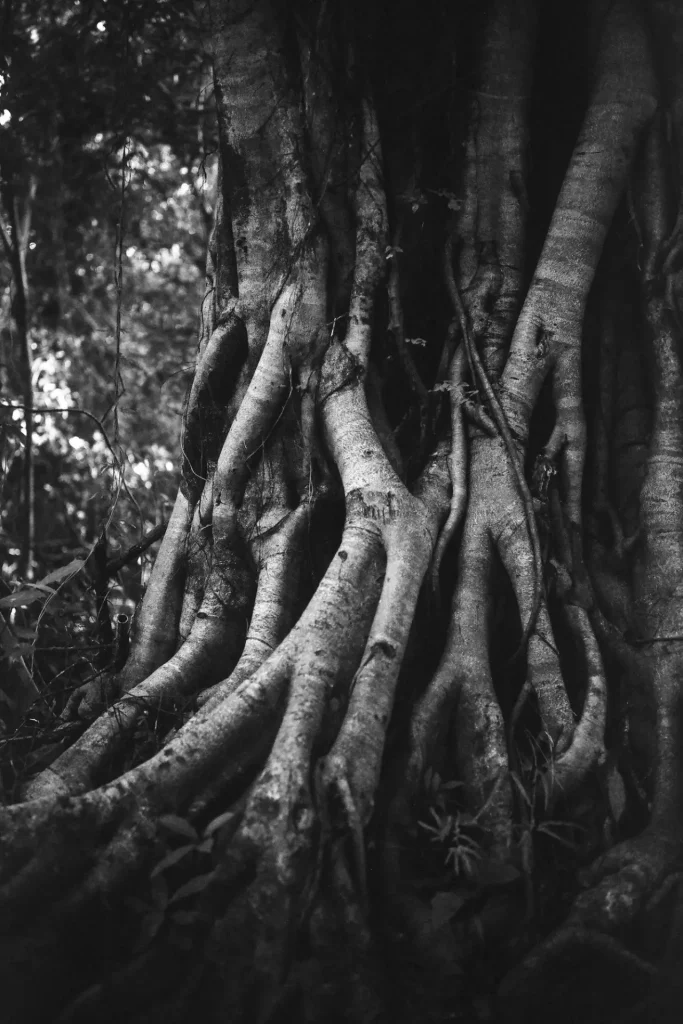

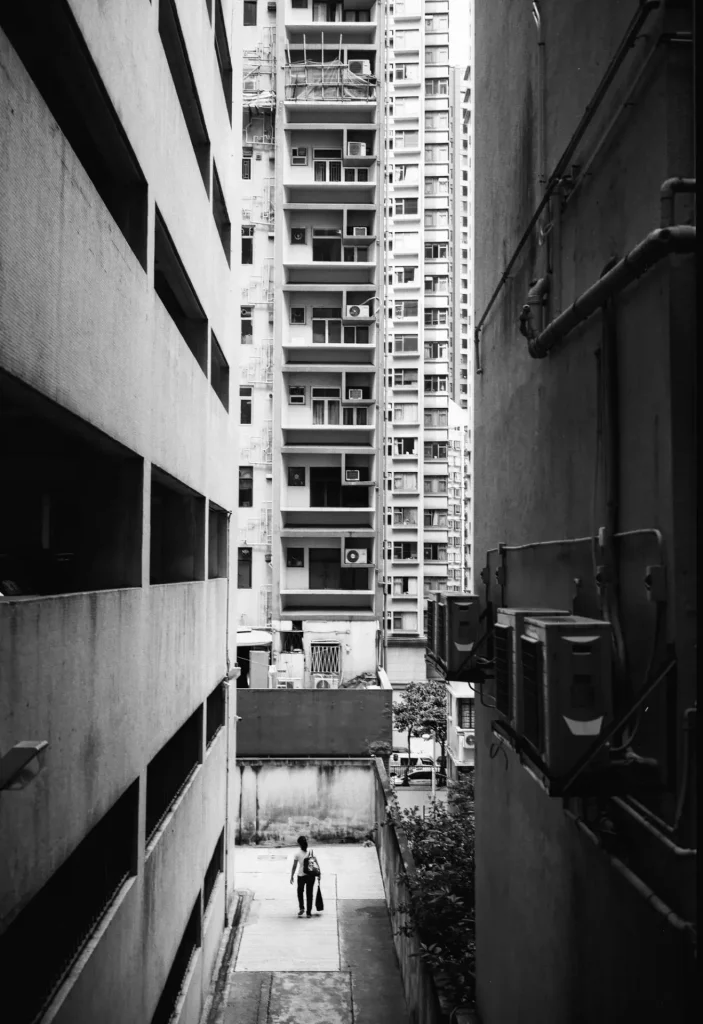

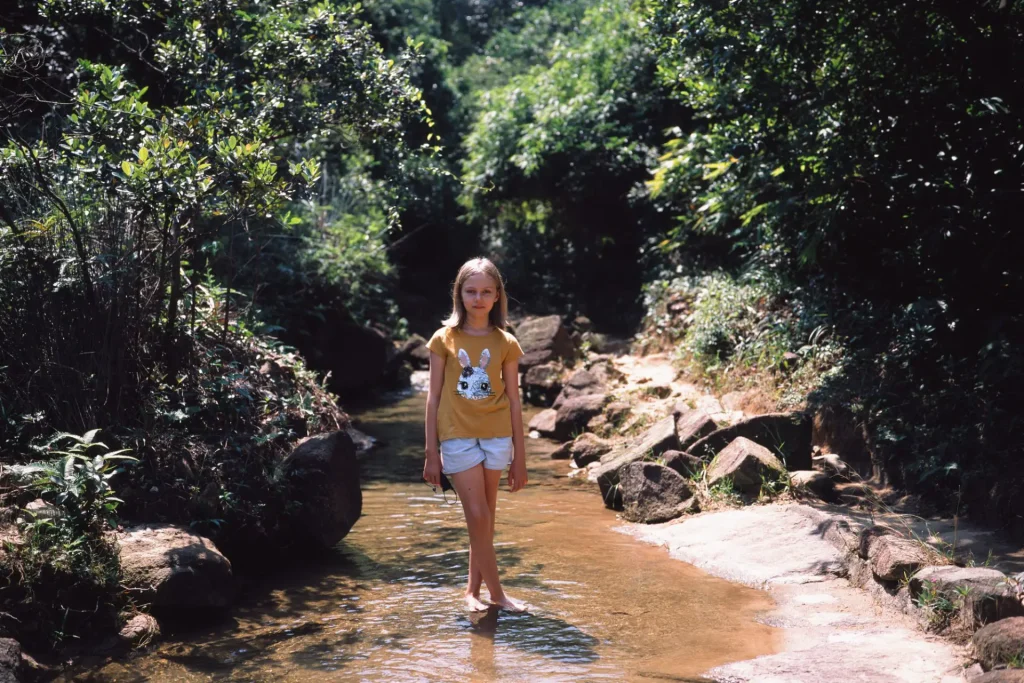

In Conclusion
So, is the Fuji GW690iii ‘Texas Leica’ the perfect medium format camera? Well, I don’t have enough MF experience to make that call anyway, and it has its share of quirks (to put it mildly), so I’d argue that it’s probably not. Of course, the fact that it’s a fixed lens is a significant constraint anyway, especially in a camera that size.
And yet for all of that, it’s a camera that I enjoy lugging around, and most importantly one that delivers stunning pictures over and over. With my 135 cameras I normally hover around 2-3 keepers in a 36 exposure roll. With the Fuji GW690iii I’ve been averaging 1-2 in an 8 exposure roll. Admittedly part of that is due to the process, and the fact that manual settings added to the clunkiness of those aperture/speed rings forces me to slow right down. But I like to think it’s also in part due to the amazing glass and the massive negatives.
Remember what I said initially: the Fuji GW690iii doesn’t get much love, which means it’s affordable. For me, in terms of quality to price, it’s a steal, and while 500 USD isn’t chimp change, it’s still in the affordable range if you want to get serious about medium format. I’m pretty sure it’s not for everyone, but for me, this is a keeper.
You can find me on instagram here: @benfelten, and other articles I have written about for 35mmc here
Share this post:
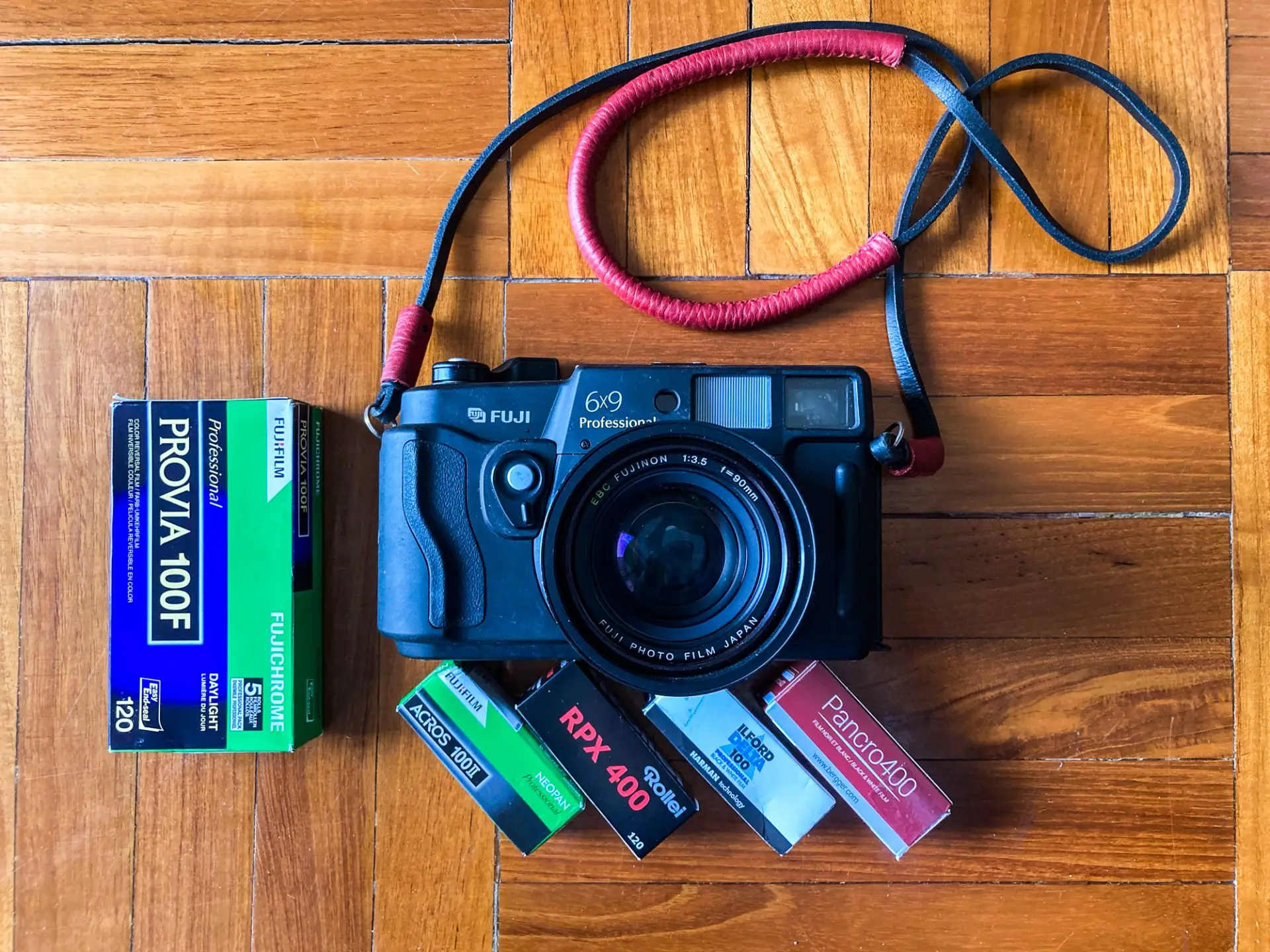








Comments
Mike on Fuji GW690iii – Hands on Review of the Texas Leica – By Benoît Felten
Comment posted: 12/01/2021
Comment posted: 12/01/2021
Wim van Heugten on Fuji GW690iii – Hands on Review of the Texas Leica – By Benoît Felten
Comment posted: 12/01/2021
Why not go the 'old style' way in T-mode and use the lens cap to finish exposure?
AFAIK the equivalent focal length is calculated from the negative diagonal (60X90 vs. 24X36). That's a factor of 0.4, so 90mm would be a focal length of 36mm in 35mm.
Comment posted: 12/01/2021
Comment posted: 12/01/2021
Bob Janes on Fuji GW690iii – Hands on Review of the Texas Leica – By Benoît Felten
Comment posted: 12/01/2021
regarding the positioning of the aperture and shutter speed rings - is it possible that you are supposed to be able to move them together but maintain the same exposure - in effect getting an exposure shift?
Comment posted: 12/01/2021
Comment posted: 12/01/2021
Neal A Wellons on Fuji GW690iii – Hands on Review of the Texas Leica – By Benoît Felten
Comment posted: 12/01/2021
I find mine easy to carry too.
For time exposures, I stop down so I won't be using only 1 or 2 seconds and use my hat as a shutter. It's fine in dark settings and always handy. I am so used to it I don't really think of it as a problem; just a quirky camera.
Phil Steelandt on Fuji GW690iii – Hands on Review of the Texas Leica – By Benoît Felten
Comment posted: 12/01/2021
Nice review and nice photos.
Indeed, it's not so easy to adjust the speed without altering the opening.
But I like the fact that, once they are set, it's easy to move the combination up or down (while keeping the right exposure) by grasping the two rings together.
And, yes, it's amazing glass and massive negatives are a joy to use.
Neil Woodman on Fuji GW690iii – Hands on Review of the Texas Leica – By Benoît Felten
Comment posted: 12/01/2021
Positives for me are
- the massive negatives! Makes 6x6 seem like micro 4/3s :D
- relative simplicity of it, mine has no meter and very little in the way of options
- the look of the images it produces is just fantastic, even if you only get 8 per roll
The downside for me is the size of the thing, but I guess that goes with the territory. It's also double-stroke too, which feels a bit odd and the noise of the shutter, a discrete camera this is not.
I use mine on a tripod all the time and shoot it at f11 to f16, I applaud you for trying to use it hand held!
James T on Fuji GW690iii – Hands on Review of the Texas Leica – By Benoît Felten
Comment posted: 12/01/2021
Comment posted: 12/01/2021
Comment posted: 12/01/2021
shootfilmnotguns on Fuji GW690iii – Hands on Review of the Texas Leica – By Benoît Felten
Comment posted: 12/01/2021
Christian Schroeder on Fuji GW690iii – Hands on Review of the Texas Leica – By Benoît Felten
Comment posted: 12/01/2021
In comparison to your iteration of the camera, I feel a bit envious to not have a shutter lock button. I always have to be very careful to not take too many frames of my camera bag’s interior. :)
herbert kateley on Fuji GW690iii – Hands on Review of the Texas Leica – By Benoît Felten
Comment posted: 12/01/2021
Comment posted: 12/01/2021
Comment posted: 12/01/2021
Kenneth Rowin on Fuji GW690iii – Hands on Review of the Texas Leica – By Benoît Felten
Comment posted: 12/01/2021
Comment posted: 12/01/2021
David Wogan on Fuji GW690iii – Hands on Review of the Texas Leica – By Benoît Felten
Comment posted: 12/01/2021
Comment posted: 12/01/2021
Andriy Kryvtsun on Fuji GW690iii – Hands on Review of the Texas Leica – By Benoît Felten
Comment posted: 12/01/2021
Could you share your example images somehow with maximum resolution? I wanna see how many details the camera can reproduce.
Comment posted: 12/01/2021
Andrea Visconti on Fuji GW690iii – Hands on Review of the Texas Leica – By Benoît Felten
Comment posted: 12/01/2021
Comment posted: 12/01/2021
Troy Phillips on Fuji GW690iii – Hands on Review of the Texas Leica – By Benoît Felten
Comment posted: 12/01/2021
Dave Haynie on Fuji GW690iii – Hands on Review of the Texas Leica – By Benoît Felten
Comment posted: 12/01/2021
davesurrey on Fuji GW690iii – Hands on Review of the Texas Leica – By Benoît Felten
Comment posted: 12/01/2021
The “crop factor” is 0.43 so this is equivalent to the same angle of view as a 28mm on 35mm. Too wide for some.
I agree that the image quality can be excellent. And the proximity of the aperture and the speed rings never caused me any problem, perhaps as I was use to this idea on my Olympus 35SP and others. Yes the T implementation is a pain but the one that really bugged me was the inability to use a filter system due to the retracting lens hood which hides the shutter and aperture rings when retracted. Dohhh!
But….the reason I sold it and prefer to use my Bronica or one of my 6x9 folders is that I never really enjoyed using it. There was just something intangible that I never liked about it as it seemed like an overgrown RF on steroids with no character. Not very logical I admit but if it doesn’t feel right then it won’t stay in my collection.
Kyle Klain on Fuji GW690iii – Hands on Review of the Texas Leica – By Benoît Felten
Comment posted: 12/01/2021
To the contrary of some of the others commenting, unfortunately the T mode doesn't work the way of other similar lenses. One must use the aperture/shutter ring or the film advance. I found a larger slip over lens cover that you can quickly put on to get around this.
The camera is really just a 4x5 rangefinder built around 6x9. The lens is exceptional, only surpassed in resolution and sharpness by two of the Mamiya 7 lenses. Color and contrast is very high and its slightly warmer than it's German counterparts.
Shooting handheld is very possible thanks to the leaf shutter! Use the front shutter release and you'll have shockingly shake free images.
Stefan Arend on Fuji GW690iii – Hands on Review of the Texas Leica – By Benoît Felten
Comment posted: 12/01/2021
Huss on Fuji GW690iii – Hands on Review of the Texas Leica – By Benoît Felten
Comment posted: 12/01/2021
Have to be very careful maintaining tension on the film when closing the back.
Wendell Cheek on Fuji GW690iii – Hands on Review of the Texas Leica – By Benoît Felten
Comment posted: 12/01/2021
Jeremy Keller on Fuji GW690iii – Hands on Review of the Texas Leica – By Benoît Felten
Comment posted: 12/01/2021
Comment posted: 12/01/2021
David McCallum on Fuji GW690iii – Hands on Review of the Texas Leica – By Benoît Felten
Comment posted: 12/01/2021
https://www.dantestella.com/technical/gsw690iii-res.html
Lens plus tmax 100 film and nikon ls 8000 scan
J on Fuji GW690iii – Hands on Review of the Texas Leica – By Benoît Felten
Comment posted: 13/01/2021
I considered the Fuji Texas Leica, but after reading comments about the noisy shutter linkage, the counter noise and the lack of a bulb setting , I opted for the Brooks-Veriwide (second version 6x9). It is lighter than the Fuji and sports a 47mm Super Angulon
(albeit only f/8, but sharp as a tack) and a really big viewfinder with parallax adjustments. No rangefinder, but I have a very nice Watameter RF when I need precise distance settings as well as a Leica Disto. The only real advantage of the Fuji over the Brooks is the larger aperture.
Comment posted: 13/01/2021
James on Fuji GW690iii – Hands on Review of the Texas Leica – By Benoît Felten
Comment posted: 14/01/2021
Tomislav on Fuji GW690iii – Hands on Review of the Texas Leica – By Benoît Felten
Comment posted: 14/01/2021
Regarding T mode... Yes Bulb mode would be nice but can it be done without battery ? I know that Mamiya RZ67 has bulb mode that uses battery and works only for 1 minute !? RB67 has only T mode just like this Fuji.
I don't really think it's a problem. I do a lot of long exposures with good sturdy tripod I don't even need dark cloth. I just use two fingers to turn shutter speed dial to close the shutter. Never had a problem. I don't know why you used film advance to do that. It needs much more force.
It may be stupid but I like the placement of aperture and shutter speed dial. It's just like on pentax digital spot meter.
I set up my camera in advance so I don't need to fiddle with it fast.
ARTHUR W GOTTSCHALK on Fuji GW690iii – Hands on Review of the Texas Leica – By Benoît Felten
Comment posted: 14/01/2021
Comment posted: 14/01/2021
Roger on Fuji GW690iii – Hands on Review of the Texas Leica – By Benoît Felten
Comment posted: 16/01/2021
Quirks and that lens hood aside it's a great camera.
Fred Pinkerton on Fuji GW690iii – Hands on Review of the Texas Leica – By Benoît Felten
Comment posted: 21/01/2022
By the way, 6X9 is not too much wider than 35mm. I find it similar regarding image composition. 35mm is 1.35:1 while 6X9 is 1.5:1
herbert kateley on Fuji GW690iii – Hands on Review of the Texas Leica – By Benoît Felten
Comment posted: 28/02/2022
nicki on Fuji GW690iii – Hands on Review of the Texas Leica – By Benoît Felten
Comment posted: 03/07/2022
Comment posted: 03/07/2022
Massimiliano Grivetti on Fuji GW690iii – Hands on Review of the Texas Leica – By Benoît Felten
Comment posted: 13/07/2024